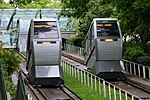Sacré-Cœur, Paris

The Basilica of the Sacred Heart of Paris, commonly known as Sacré-Cœur Basilica and often simply Sacré-Cœur (French: Basilique du Sacré-Cœur, pronounced [sakʁe kœʁ]), is a Roman Catholic church and minor basilica in Paris, France, dedicated to the Sacred Heart of Jesus. Sacré-Cœur Basilica is located at the summit of the butte Montmartre, the highest point in the city. It is a popular landmark, and the second-most visited monument in Paris. Sacré-Cœur Basilica has maintained a perpetual adoration of the Holy Eucharist since 1885. The basilica was designed by Paul Abadie. Construction began in 1875 and was completed in 1914. The basilica was consecrated after the end of World War I in 1919. It is considered as both a political and cultural monument, representing a national penance for the defeat of France in the 1870 Franco-Prussian War and for the actions of the Paris Commune of 1871. The church was constructed close to the site of the beginning of the Paris Commune where, on March 18, 1871. Communard soldiers killed two French army generals and seized a park full of artillery. There was (and remains) a feeling of resentment on the French left that the massacre of the Communards was commemorated by a temple of a fundamentally conservative religion. So great was the dislike of Sacré-Cœur at the fin de siècle that the Montmartre group of artists, including van Gogh, Matisse, Degas and Toulouse-Lautrec, decamped en masse to Montparnasse.
Excerpt from the Wikipedia article Sacré-Cœur, Paris (License: CC BY-SA 3.0, Authors, Images).Sacré-Cœur, Paris
Rue du Chevalier de la Barre, Paris Quartier de Clignancourt (Paris)
Geographical coordinates (GPS) Address Website External links Nearby Places Show on map
Geographical coordinates (GPS)
| Latitude | Longitude |
|---|---|
| N 48.88665 ° | E 2.34295 ° |
Address
Basilique du Sacré-Cœur (Basilique du Sacré-Cœur de Montmartre)
Rue du Chevalier de la Barre 35
75018 Paris, Quartier de Clignancourt (Paris)
Ile-de-France, France
Open on Google Maps










